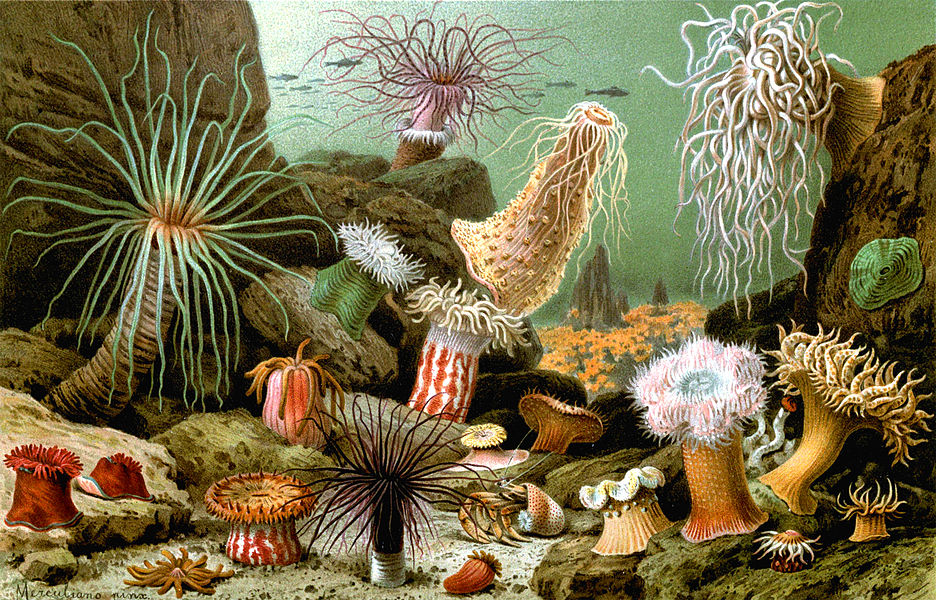 1
1title: Caspar David Friedrich Wanderer above the sea of fog
artist: Caspar David Friedrich
date: circa 1817
medium: Oil on canvas
dimensions: Size cm 98 74
current location: Institution:Hamburger Kunsthalle
source: The photographic reproduction was done by [[User:Cybershot800i|Cybershot800i]]. ([link Diff])
credit: The photographic reproduction was done by Cybershot800i. (Diff)
description:
The hiker stands as a back figure in the center of the composition. He looks down on an almost impenetrable Sea of fog in the midst of a rocky landscape - a metaphor for life as an ominous journey into the unknown.license:Public domain
 2
2title: William Adolphe Bouguereau (1825-1905) - The Wave (1896)
artist: William-Adolphe Bouguereau
date: 1896
medium: Oil on canvas
dimensions: size cm 121 160.5
current location: Private collection
source: link
credit: link
license:Public domain
 3
3title: Actiniaria
artist:
Giacomo Merculiano (1859–1935)date: 1893
source: [link ''The royal natural history'']
credit: The royal natural history
description: Various examples of Sea anemones (1893 print).
license:Public domain
 4
4title: Joseph Mallord William Turner The Sun of Venice Going to Sea - Google Art Project
artist: J. M. W. Turner
medium: technique Oil canvas
dimensions: size cm height=616 width=921
current location: room|T7) Institution:Tate Britain
source: From Google Cultural Institute|dwEYd5yKW43wWQ Tate Images (link)
credit: dwEYd5yKW43wWQ at Google Cultural Institute, zoom level maximum Tate Images (link)
license:Public domain
 5
5title: Gviana siue Amazonvm Regio.
artist: Willem Blaeu
date: 1635 (undated)
dimensions: Size unit=in width=20 height=15
source: Blaeu, G., <i>Atlantis Appendix, sive pars altera, continens tab. geographicas diversarum Orbis regionum</i>, 1630. Geographicus-source
credit: This file was provided to Wikimedia Commons by Geographicus Rare Antique Maps, a specialist dealer in rare maps and other cartography of the 15th, 16th, 17th, 18th and 19th centuries, as part of a cooperation project.
description: This is G. Blaeu's remarkable c. 1635 map of the northeastern parts of South America , Lake Parima (Parime Lacus), and the route to El Dorado. Blaeu initially issued this map in 1630 and variants were published well in to the 1660s. This example dates to the 1635 German edition of Blaeu's atlas. The map covers from Isla Margarita and the Orinoco Delta eastward as far as Tampico and southwards as far as the Amazon River. This region of South America generated considerable European interest in the early 17th century following the publication of Sir Walter Raleigh's fascinating Discovery of the Large, Rich, and Beautiful EMPIRE Of GUIANA . Raleigh's expedition traveled down the Orinoco River in search of the Kingdom of El Dorado. Today we know that El Dorado did not exist, but was rather an amalgam of very real tribal traditions and the European lust for gold. Nonetheless, in the 16th century, tales of El Dorado were common conversation along the port cities of the Spanish Main. Having explored a considerable distance down the Orinoco, Raleigh's expedition found itself mired in a remote tribal village at the onset of the rainy season. While waiting for an opportunity to return north, a trading delegation arrived. At this time the dominate trading empire in the Amazon were the Manoa, who, though based near modern day Manaus, pursued trade routes to from the foothills of the Andes to the Amazon and Orinoco Deltas. While the rainy season prevented Raleigh from moving forward, for the Manoa it had the opposite effect. The heavy rains inundated the vast Parima flood plain creating a great inland Sea, consequently opening an important trade connection between the Amazon and Orinoco Rivers. When the Manoa arrived, Raleigh and his men noticed that they had various golden trinkets for sale. This was apparently enough for Raleigh to deduce that they must indeed be from the hidden kingdom of El Dorado. When Raleigh asked where the traders came from, the locals, with no common language with which to engage Raleigh, could only explain that they traveled across a great water and were from Manoa. Raleigh's presumptuous narrative inspired many early cartographers to map this massive lake, with the city of El Dorado or Manoa on its shores, in the unexplored lands between the Orinoco and Amazon River basins. In addition to Blaeu's fascinating depiction of Lake Parima, among the most prominent such in any mapping of this region, there are also a number of attractive decorative elements. Three sailing ships ply the waters and just under the compass rose a scary looking Sea monster swims toward shore. A decorative baroque title cartouche appears in the upper right quadrant and, at the bottom of the map, to small cartouches frame a distance scales and Blaeu's signature. Uncolored as issued.
license:Public domain
 6
6title: Willem van de Velde II Dutch men-o'-war and other shipping in a calm
artist: Willem van de Velde the Younger
date: Circa 1665
medium: Ucfirst: Oil on canvas
dimensions: Size cm height=86.8 width=120
current location: Institution:Rijksmuseum Amsterdam
source: Rijksmuseum * Permalink: link
credit: Rijksmuseum Permalink: link
license:Public domain
 7
7title: Albert Bierstadt Seal Rock, California
artist: Albert Bierstadt
date: circa 1872
medium: Technique oil paper mounted=canvas
dimensions: Size cm 40.6 55.9
source: Christie's online|ID=5436885|sale=2444|lot=37, New York, 18 May 2011
credit: Christie's, LotFinder: entry 5436885 (sale 2444, lot 37, New York, 18 May 2011)
license:Public domain
 8
8title: Canaletto Bucentaur's return to the pier by the Palazzo Ducale - Google Art Project
artist: Canaletto
date: between 1727 and 1729
credit: Canaletto
license:Public domain
 9
9title: Paul Gauguin Fatata te Miti (By the Sea) - Google Art Project
artist: Paul Gauguin
date: 1892
credit: qwF_p9DsSxWadw at Google Cultural Institute, zoom level maximum
license:Public domain

title: Andromeda and the Sea Monster, and Leda and the Swan, 11364501
artist: Massimiliano Soldani Benzi
date: 1725
source: link
description: Andromeda and the Sea Monster (right); Leda and the Swan (left). Bronze on grey-green marble bases with bronze mounts, 49.6 × 33.3 × 20.7 cm (19 1/2 × 13 1/8 × 8 1/8 in.), designed before 1717; cast about 1725. Object Number: 97.SB.61.1.
As a Sea monster lunges towards her, the nude Andromeda recoils, straining against the chains that tie her to the rocky ledge. Her hair blows behind her, indicating sudden movement. The sharp angles of her eyebrows and nose express anxiety, while the diagonal of her body expresses the repulsion she feels towards the growling beast.
Andromeda and the Sea Monster depicts a dramatic moment from the ancient Greek author Euripides' tale of Andromeda and Perseus. Andromeda's mother angered the gods with her boast that Andromeda was more beautiful than the Nereids, the attendants of the god of the Sea, Poseidon. To appease the offended Poseidon, who threatened to destroy their entire kingdom, Andromeda's parents sacrificed their daughter by leaving her where she would be devoured by his monster. As Andromeda awaits the monster, chained to a rock, Perseus flies overhead, falls instantly in love with her, and rescues her by slaying the beast. Massimiliano Soldani Benzi's interpretation of the story is unusual because he focused on Andromeda's horror at the monster instead of on her rescue.
Master sculptor Massimiliano Soldani Benzi cast the bronze groups of Andromeda and the Sea Monster and Leda and the Swan as pendants. Each depicts an episode from classical mythology, and the two are visually linked by opposing compositions. Leda reclines, forming a diagonal from the lower right to the upper left. This line is balanced by that created by Andromeda—a diagonal moving from the lower left to the upper right—as she attempts to escape. Both figures also display heightened emotion: Leda expresses seductive eroticism, and Andromeda expresses terrifying horror.
Each group retains its original base, golden reddish lacquer patina, and elaborate matching bronze mounts on the base.
Description: [CC-BY-SA-4.0] J. Paul Getty Trust.license:Public domain





